Renee Fleuranges-Valdes brings her whole heart to her art, and her stories are stitched just as richly as her quilts. Renee’s journey is rooted in joy, resilience, and deep reflection. In this interview, she shares the moments, inspirations, and life experiences that continue to shape her extraordinary work.
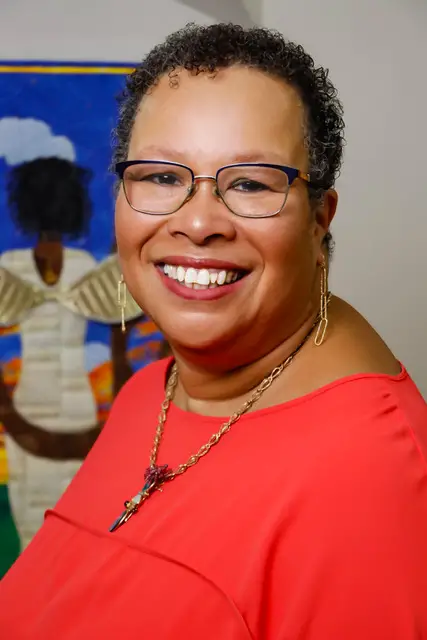
When did you first start working with fabric and sewing?
I started sewing at a young age. My mother was my first teacher—she made all our clothes (yes, youngest of four girls here!).
I also learned from my aunt, my mom’s sister, who worked in the NYC garment district. On weekends, she’d bring home piecework, and I’d sit at her feet snipping threads as she stitched lingerie. I didn’t know it then, but I was getting my first glimpse into the world of craftsmanship and design—how something beautiful takes shape from repetition, patience, and precision.
That early exposure to fabric, form, and finish gave me a foundation I still rely on today. It also taught me the value of earning and creating something of my own; those extra dollars from cleaning threads became my fabric and pattern money.
As an Amazon Associate I earn from qualifying purchases. Read more about our affiliate linking policy.
By seventh grade, I was making my own clothes and learning how to alter patterns to fit the look I envisioned—an early sign, I suppose, of the designer and artist I would one day become.
Was there a moment or a person who made you want to try quilting?
My first introduction to quilting came in high school, through my best friend’s mom. She made the most beautiful nautical quilts—classic and comforting. My girlfriend had no interest in learning, but her mom insisted she make at least one quilt, and I was right there as she pushed through. Her quilting never went much further, but the spark was quietly lit in me.
Years later, after her mother’s passing, that same friend encouraged me to inherit her quilting supplies. It felt like a full-circle moment—a gentle nudge from above, maybe. At the time, I was juggling the stress of married life, motherhood, and a demanding corporate career. I needed something restorative, something that belonged entirely to me. So I took my first quilting class, and the rest, as they say, is history.
That’s when quilting shifted from a curiosity to a lifeline—a way to channel energy, emotion, and reflection into something tangible. I still use some of the tools I inherited from that “second mom,” a reminder that my creative journey began not with a plan, but with love, legacy, and timing that was just right.

Tell us more about your leap leaving a corporate job to become a full-time artist. How did that change feel at first? Scary, exciting, both?
All of the above—and then some! I hadn’t planned to retire quite yet, but my husband had been nudging me to join him in that next chapter. When the timing finally lined up professionally, I decided to take the plunge. Of course, in true Renee fashion, I didn’t leap without a plan. I built a five-year transition roadmap—what my son affectionately calls “Renee 2.0.”
For decades, quilting had been my creative outlet amid a demanding corporate career full of travel, mentoring, and leadership roles. But as my passion for quilting deepened, I began to see it as more than just a hobby—it was calling me to something more intentional. So when the opportunity arose, I chose not to see it as retirement, but as a career shift. This time, I would devote myself fully to something that brought me pure joy.
That transition wasn’t just about changing how I spent my days; it changed how I saw myself. I went from managing teams and projects to nurturing ideas, fabric, and stories. It was exhilarating, a little scary, but ultimately liberating. My husband still teases that his vision of “our retirement” looked a bit different—but I make sure to balance the quilting with family time, grandkids, and travel that doesn’t require hauling a sewing machine along and visiting every quilt shop in town!
What inspires your work?
My inspiration comes from everyday life. I’ve always been an optimist—the kind of person who sees the glass not just half full, but at least three-quarters! I don’t dwell on the negative; I look around and see possibility, wonder, and beauty in the ordinary.
My mother used to squirm whenever I had to make a design decision, whether in sewing or decorating the house. For me, it wasn’t right until my heart sang. I’d say, “It has to sing, Mom!” and she’d roll her eyes and ask, “Does it always have to sing?” Yes, Mom—it always does. That instinct, that emotional resonance, has become my compass as an artist.
Over time, that simple idea of joy evolved into something deeper. My art became less about what I saw and more about what I felt. Every piece now carries a spark of that optimism—sometimes bold and radiant, sometimes quiet and reflective—but always rooted in joy. In a world that often focuses on struggle and sorrow, I choose to shine a light on the beauty that persists through it all. When my art sings, it’s my heart’s way of reminding me—and hopefully others—that joy is still out there, waiting to be found.
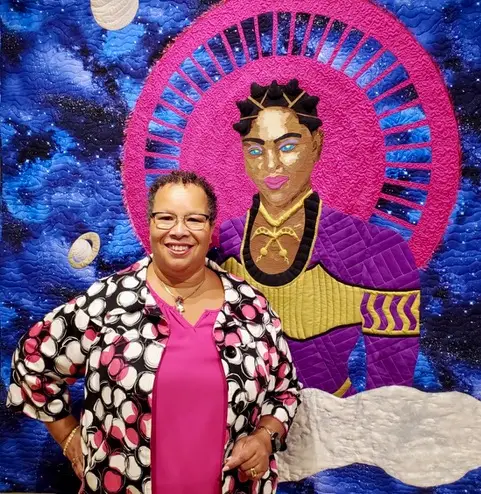
How do your family and cultural roots show up in your work?
My family is what grounds me—it’s what makes me whole. Have you ever heard someone refer to a dog as “a mutt,” meaning a mix of many breeds? Well, that’s me—my ancestral roots are woven through the soil of almost every continent. I like to think of myself as a true American, a reflection of the melting pot our forefathers envisioned when they said, “Give us your tired, your poor…” That diversity—in look, mind, and spirit—flows through every piece I create.
When I first began incorporating people into my work, I used Black fabric, inspired by Victorian-era European silhouettes. But as I continued to grow as an artist and explore my own heritage more deeply, I realized that my work needed to reflect the full tapestry of who I am. My ancestry isn’t one note—it’s a symphony of cultures, histories, and colors.
Today, my art celebrates that richness. Yes, I am a proud African American woman, but my skin color alone doesn’t define me or the stories I tell. My work aims to honor the beauty of diversity itself—the strength that comes from difference, the harmony that lives in complexity. As my understanding of self has evolved, so too has my art, expanding from representation to revelation.
You’ve worked in several series. Do you plan the whole story for a series, or does it grow as you make each piece?
Since life is my inspiration, I’ve never been one to over-plan my series work. Commissions and Calls for Entry—yes, those get mapped out. But when it comes to my personal work, I let intuition lead the way. I usually begin with a concept I want to explore deeply, and I create the first piece simply to see where it wants to take me. The rest of the series unfolds in its own time—sometimes months later, sometimes years.
Take my Dream Big series, for example. It began in 2016 with a handful of ideas—six, to be exact—that quickly grew to eight as the series found its voice and following. At the time, I felt I had said everything I needed to say on the subject, so I stepped away. But art, like life, has a way of circling back. In 2024, I revisited Dream Big—this time with a deeper understanding of both myself and the world around me. The timing felt right again.
That’s the beauty of working in series: each piece marks a moment in time, a step in my evolution. I may start a series with one idea, but it inevitably grows as I grow. The art teaches me as much about the subject as it does about myself.

Which series felt the most personal or brave to make, and why?
While all my art is personal, not every piece belongs to a series—especially my earlier works or those created in response to Calls for Entry. As a storytelling, representational art quilter, I don’t think of my work as requiring bravery. I simply strive to tell my stories. And if a story isn’t ready to be told, it doesn’t make its way into my art.
That said, there are pieces that were deeply personal—works that helped me process difficult emotions. I often say I have two very “salty” quilts, because I cried my eyes out making them. The “salt” came from the tears I shed while working through some of life’s hardest moments.
Both pieces are connected to my role as caregiver and healthcare advocate for my mother, who lived courageously with Alzheimer’s and survived breast cancer three times. The first, A Mother’s Legacy, was created when we could no longer care for her in her home of 57 years and had to move her into a memory care facility. I still remember her standing in the doorway, stomping her feet and begging us to take her home. But that wasn’t the mother I wanted to remember—so I made a piece that reflected the woman who raised me: poised, passionate, and proud.
The second, 4X Stronger, came when my sisters and I had to make the heart-wrenching decision to authorize a mastectomy for my mother’s third bout of breast cancer. How do you make that decision for another woman? But Alzheimer’s made her incapable of choosing for herself. The tears flowed again. The piece was originally titled 3X Stronger, but I renamed it after my own diagnosis a few years later—when I found myself crying into it once more.
Those pieces continuously remind me that art can hold both grief and grace in the same stitch. Over time, I’ve realized that my quilts don’t just tell stories—they heal them. Each time I return to the fabric, I see how far I’ve come, and how my art continues to teach me about love, resilience, and the quiet strength that runs through generations of women in my family.

Describe your creative space.
In New York, I created in the basement—a space with little natural light that I shared with the family laundry and my children. As they became teenagers, that meant I was frequently kicked out!
One of the best parts of relocating after retirement was being able to make my studio a top priority when choosing our new home. In South Carolina, I wanted a large, dedicated space where I could truly create. My 600+ sq ft studio now has plenty of room for my six-foot cutting table, long arm on a ten-foot frame, a full ironing station, a desk, a printing area, and plenty of storage. Oh yes, natural light pouring in.
But the heart of my studio is the ten-foot by eight-foot design wall. It gives me the freedom to step back, view my work from different angles, and let it evolve over time. I don’t have to take a piece down when I need to let it “sit and simmer” while I move on to something else—that’s when some of my best ideas have room to unfold.

What does a regular day in your studio look like?
I don’t think I have a “regular” routine—and honestly, I enjoy life too much to follow one at this stage. Quilting is my passion, but it isn’t all-consuming. I stay pretty busy with plenty of things outside the studio.
When I am in my studio, it’s usually very quiet. I rarely have the TV or music on; I prefer to work in silence. I talk to my work—and to myself—most of the time. Sometimes it’s a whisper, other times it’s out loud. Anything else just feels like a distraction. My husband will occasionally call up the stairs and ask who I’m talking to, and I’ll tell him, “No one—my art was trying to tell me something, and I had to listen and reply!”
As I create, I spend a lot of time drawing and redrawing my main figures. I have to make sure their posture suggests the right amount of movement—a critical component of a successful piece of my work. And because color is so important in setting the right tone, I take my time auditioning fabrics until it feels just right, sending out the right energy. As I work, the piece begins to “speak,” guiding me toward the scene my figures belong in and what kind of quilting and embellishment will bring it to life. You see, I work quite organically—constantly adjusting and refining as I go.
Do you sketch or draft before you cut fabric, or do you make it up as you go?
While I work organically, I do sketch the main player in a piece—whether it’s a person, a mask, or a more traditional leaning project. I like to have a solid idea of what that key element will look like before I cut into fabric.
Beyond that, the rest of the design is guided by what the main player “wants.” I always let the project lead the way, and I’ve been known to change the main player several times during the process. Nothing is final until the quilt itself tells me it’s done.
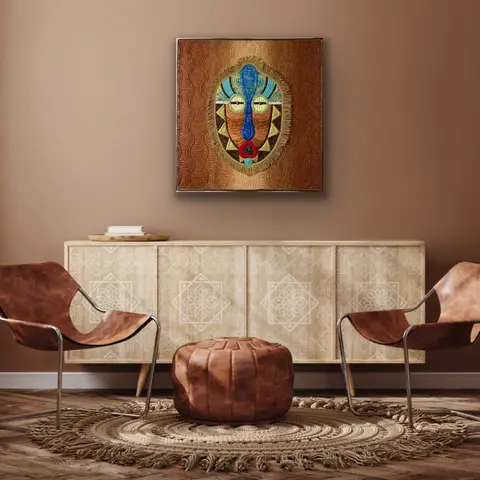
When a piece is not working, how do you fix it?
I don’t force it. I let a piece sit if I’m not happy with it. In fact, I’ve let work sit for years. Surprisingly, every time I pull one of these out again and complete it, I realize the reason it wasn’t working is because I didn’t yet have the skill—or the perspective—to take it where it wanted to go. It always amazes me in the end, it reminds me I can’t control everything. Sometimes you just have let things go in life.
One such piece was my daughter’s wedding quilt. She wanted a two-sided quilt: a traditional signature backing where guests would sign the pieced back at the wedding; yet she gave me the freedom to design the front as I wished—with three caveats: the colors had to be red, black, and white; it had to include their monogram; and it needed a traditional flair. For the art quilter I am, that felt like being handcuffed three times!
I made it through the creation of the quilt top just fine, but how to quilt it—so the quilting made sense on both sides—was a puzzle I couldn’t solve. So it sat. For five years. Then one night, it clicked. I suddenly knew exactly what I wanted to do, and by then, I had the longarm skill to do it. I didn’t have that five years earlier.
That experience taught me one of the most valuable lessons in my artistic journey: sometimes a piece isn’t ready because we aren’t ready. Growth, both technical and emotional, is part of the process. Some quilts teach you patience before they ever teach you technique.
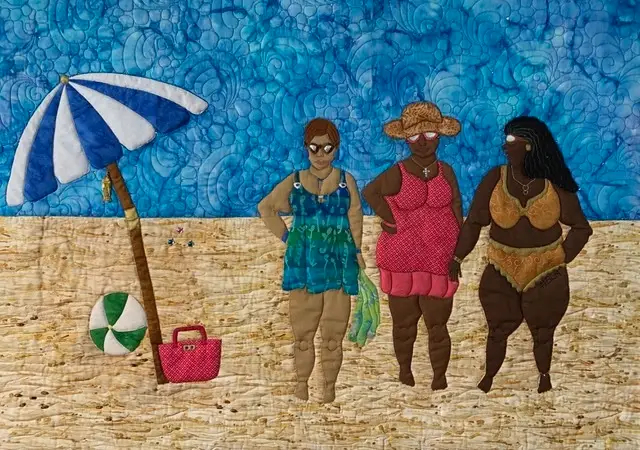
What is your favorite part of making a quilt: design, piecing, quilting, finishing?
My favorite part is taking a concept and bringing it to life. That process combines many elements I love—the design, creating the main figure or appliqué, and the quilting itself. Putting a character into a scene isn’t always “fun,” but it’s essential to making the piece work, and I’ve learned over time that the scene often guides the story more than I do.
I also love machine quilting. It allows me to get lost in the rhythmic motion of moving as one with my machine. Funny thing, my quilting is very detailed, so by the time I’m halfway through quilting a piece, my mind has usually drifted to the design of the next piece. I become sort of entangled in the creative process as it keeps expanding and evolving.
I must admit, I despise the finishing process. But through experience, I’ve learned that attention to detail in this phase is critical to a piece that hangs beautifully on a wall. Over the years, I’ve come to appreciate that every stitch, every seam, every carefully squared corner is part of the growth of a quilt—and of me as an artist.
Do you favor hand work, machine work, or a mix of both? Why?
Simple answer…machine work hands down! Why? I don’t have the attention span needed to do the detail I do by hand. It takes too long! Plus there is no way I will live long enough to make all the work I want to do if I did it all by hand!
How has making art shaped who you are as a person?
Oh wow… has it ever. I think the biggest impact has been the self-reflection. All those quiet hours in my studio, alone with my thoughts and fabric, have allowed me to examine why I create, what I create, and how I do it. It has given me a space to express my inner life without words, without judgment.
I create first for myself, often asking, Why this? Why now? And more often than not, the answers surprise me—sometimes even shock me. That introspection spills over into every aspect of my life: how I interact with others, where I give my energy, and the choices I make about who and what I invest my energy in.
Art has taught me that understanding oneself is a journey, and that quiet reflection can guide not only creativity, but character. The quilts are my stories—sometimes shared, sometimes private—but through them, I’ve learned to see myself more clearly and navigate life with intention and heart.
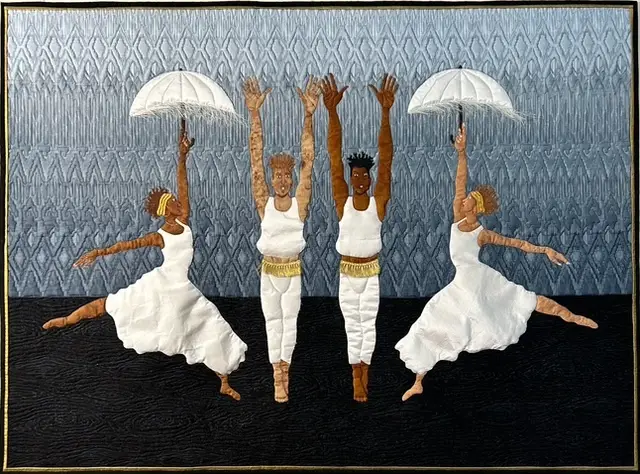
What advice would you give to someone who wants to move from hobby sewing to art quilting?
Get going. You’ll know if it’s for you once you dive in. Try all different techniques, take as many classes with different teachers as you can—whether in person or online. And don’t worry about finishing every project perfectly. The goal is to play and experiment. Give yourself permission to explore without guilt; no one masters a new skill on day one.
If you enjoy it, keep at it. If not, try something else. Along the way, grow your network of quilty friends and ask them tons of questions. If you’re comfortable with social media, follow as many quilters as you can—at first, let yourself absorb everything. You can always unfollow later.
And most importantly: remember, this is your playground. Fun and curiosity come first. If someone judges, politely remind them that your studio—your creative space—is governed by your rules. Over time, this freedom to explore and experiment will help your skills, confidence, and artistic voice grow in ways you never imagined.
How do you hope your quilts connect with the people who see them?
Simple: I hope they move people. I hope the details pull viewers in for a closer look, and then that they stand back—or even sit with a piece for a while—and feel whatever emotions drew them in. I love watching people engage with my work at shows and exhibits, especially when they don’t know who I am. Their reactions, the subtle pauses, the conversations they have with each other, are endlessly fascinating.
Because my art tells personal stories, few understand the “why” behind a piece unless I share it. And that’s okay. I’m happy if they enjoy it for its beauty and the joy it radiates. Over the years, I’ve learned that the connection isn’t always about explanation—it’s about feeling. A quilt can communicate without words, and that unspoken dialogue between art and viewer is where the magic truly happens.
What’s next for you?
Well, I just released my first book—a storytelling coffee table book. Becoming the Light shares the narratives behind 40 of my art quilts, delving into my values, the cultural influences that have shaped me, and the things I care about most.
The book is deeply personal. It’s about how art—and the stories we tell through it—can create connection, healing, and joy. My hope is that as people read these stories, they pause to reflect on the emotions my art stirs within them. That they sit with their own feelings and ask, Why do I feel this way?
To me, that conversation between art and heart is where inner reflection begins. This book represents the next stage in my journey as an artist: not just creating for myself, but creating a space for others to reflect, connect, and perhaps even heal alongside my work. It will be interesting to see how much of my art intentionally becomes centered around societal reflection, versus my own personal journey. But, only time will tell.
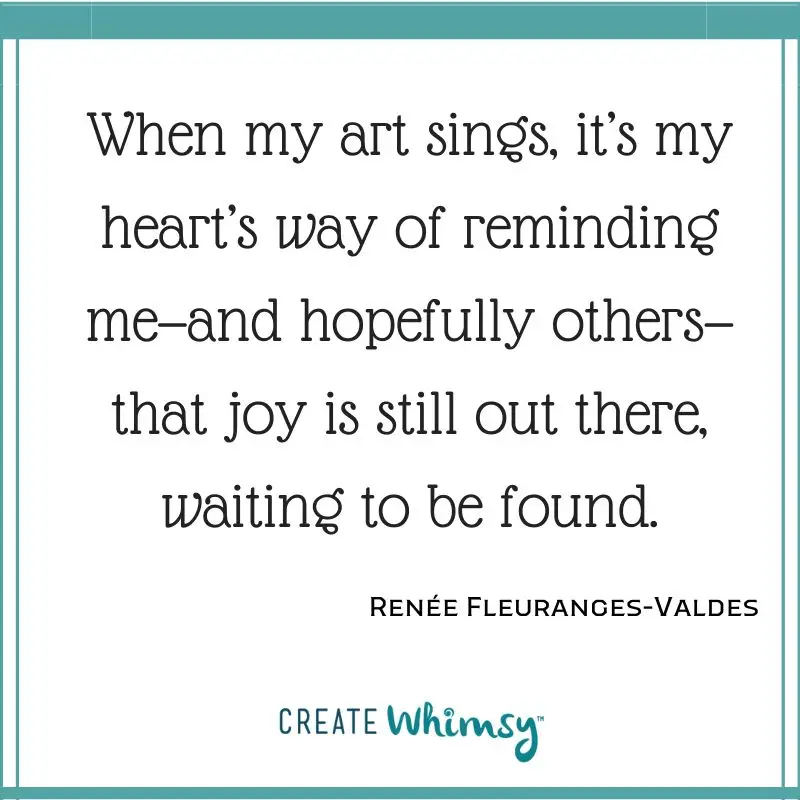
Where can people see your work?
Online, people can explore the gallery on my website: www.quiltedartistrybyrenee.com. They can also follow me on Instagram as @quiltedartistry.
I participate in many group shows year round. In 2026, I am happy to say that I will have a solo show, Finding Joy!, at the Morris Center For Lowcountry Heritage. It’s always a special experience to meet viewers and watch how my quilts resonate with them in person. And as a special treat, they can join me on my first quilting cruise in 2027… A Mediterranean Quilting Cruise.
Details on events, shows and the cruise can be found on my website as well.
In closing, quilting is my language, my way of turning life’s moments—joys, struggles, and quiet reflections—into something visible and lasting. Each stitch carries a story, a memory, a piece of my heart. Through color, texture, and form, I explore who I am, honor where I come from, and reach toward the light. In every quilt, I invite others to pause, feel, and connect, sharing in the beauty and the grace woven into each piece.
Interview posted November 2025
Browse through more inspiring art quilts on Create Whimsy.
